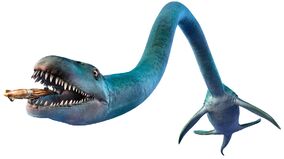(This page now has much more info on this elasmosaur other than, "Albertonectes was a plesiosaur.") Tag: Visual edit |
m (ignore this) Tag: Visual edit |
||
| Line 1: | Line 1: | ||
[[File:Albertonectes sum8ud.jpg|thumb|284x284px]] |
[[File:Albertonectes sum8ud.jpg|thumb|284x284px]] |
||
| − | '''''Albertonectes''''' '''(Alberta swimmer) '''was a [[ |
+ | '''''Albertonectes''''' '''(Alberta swimmer) '''was a [[plesiosaur]] famous not only for being particularly large for its kind, but also for having one of the most complete skeletons found for any plesiosaur. It has a crazy total of 76 tiny neck vertebrae and could reach up to 12 m long. |
== Paleoecology == |
== Paleoecology == |
||
Revision as of 16:33, 27 March 2019

Albertonectes (Alberta swimmer) was a plesiosaur famous not only for being particularly large for its kind, but also for having one of the most complete skeletons found for any plesiosaur. It has a crazy total of 76 tiny neck vertebrae and could reach up to 12 m long.
Paleoecology
Albertonectes, like the rest of the elasmosaurs, had a very specialized feeding style in that it would sneak under a large school of fish. Then, with the help of its highly flexible neck, its head would dart up and go on a feeding frenzy. How did this neck work? I did mention earlier that Albertonectes had many, small neck vertebrae. These, opposed to a few, large neck vertebrae in that if you tried to bend your theoretical long neck, those neck bones wouldn't exactly bend with you. This was exactly why the elasmosaurs developed this adaptation to make their feeding strategy more efficient, and why modern giraffes have such stiff necks.

Albertonectes, as its name implies, lived in what is now Alberta, in the Late Cretaceous period. Due to its huge size, it did not have many predators, although the mosasaurs were probably its primary threat. It went extinct a few million years before the KT extinction. This may be due to it evolving into the even larger Elasmosaurus, spelling doom for those that didn't change.